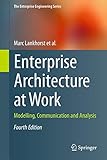Enterprise architecture at work : modelling, communication and analysis / Marc Lankhorst....[et.al.]
Material type: TextSeries: Enterprise engineering seriesPublisher: Berlin, Germany : Springer, 2017Edition: 4th edition; Fourth editionDescription: 1 online resource (xxv, 360 pages) : illustrations (some color)Content type:
TextSeries: Enterprise engineering seriesPublisher: Berlin, Germany : Springer, 2017Edition: 4th edition; Fourth editionDescription: 1 online resource (xxv, 360 pages) : illustrations (some color)Content type: - text
- computer
- online resource
- 3662539330
- 9783662539330
- 658.4/038011 23
- T58.6
| Item type | Current library | Call number | Status | Date due | Barcode | |
|---|---|---|---|---|---|---|
| E-Resources | Main Library E-Resources | 658.4/038011 L289 (Browse shelf(Opens below)) | Available | E003054 |
Browsing Main Library shelves, Shelving location: E-Resources Close shelf browser (Hides shelf browser)
Includes bibliographical references and index
Foreword to the Fourth Edition; Foreword to the Third Edition; Foreword to the Second Edition; Foreword to the First Edition; Preface; Audience; Overview of the Book; Acknowledgements; Contents; List of Contributors; Chapter 1: Introduction to Enterprise Architecture; 1.1 Architecture; 1.2 Enterprise Architecture; 1.3 The Architecture Process; 1.4 Drivers for Enterprise Architecture; 1.4.1 Internal Drivers; 1.4.2 External Drivers; 1.5 Summary; Chapter 2: State of the Art; 2.1 Enterprise Architecture and Other Governance Instruments; 2.1.1 Strategic Management; 2.1.2 Business Model Development
2.1.3 Business Architecture2.1.4 Quality Management; 2.1.5 IT Governance; 2.1.6 IT Service Delivery and Support; 2.1.7 IT Implementation; 2.2 Architecture Methods and Frameworks; 2.2.1 The IEEE 1471-2000/ISO/IEC 42010 Standard; 2.2.2 The Zachman Framework; 2.2.3 The Open Group Architecture Framework; 2.2.4 OMG¿› Model-Driven Architecture; 2.2.5 Other Frameworks; 2.3 Description Languages; 2.3.1 IDEF; 2.3.2 BPMN; 2.3.3 UML; 2.3.4 Architecture Description Languages; 2.3.5 Suitability for Enterprise Architecture; 2.4 Service-Oriented Architecture; 2.4.1 Service-Oriented Technologies
2.4.2 Relevance and Benefits for Enterprise ArchitectureChapter 3: Foundations; 3.1 Getting to Grips with Architectural Complexity; 3.1.1 Compositionality; 3.1.2 Integration of Architectural Domains; 3.2 Describing Enterprise Architectures; 3.2.1 Observing the Universe; 3.2.2 Concerns; 3.2.3 Observing Domains; 3.2.4 Views and Viewpoints; 3.2.5 Ways of Working; 3.2.6 Enterprise Architecture Models; 3.3 Pictures, Models, and Semantics; 3.3.1 Symbolic and Semantic Models; 3.3.2 Symbolic Models; 3.3.3 Semantic Models; 3.3.4 Semantics in ArchiMate Versus UML; 3.4 Summary
5.6 Motivation Concepts5.6.1 Stakeholder, Driver and Assessment; 5.6.2 Goal, Requirement, Constraint and Principle; 5.6.3 Value and Meaning; 5.7 Strategy Concepts; 5.7.1 Defining Capabilities; 5.8 Business Layer Concepts; 5.8.1 Business Structure Concepts; 5.8.2 Business Behaviour Concepts; 5.8.3 Higher-Level Business Concepts; 5.9 Application Layer Concepts; 5.9.1 Application Structure Concepts; 5.9.2 Application Behaviour Concepts; 5.9.3 Business-Application Alignment; 5.10 Technology Layer Concepts; 5.10.1 Technology Structure Concepts; 5.10.2 Technology Behaviour Concepts
Chapter 4: Communication of Enterprise Architectures4.1 Introduction; 4.2 System Development as a Knowledge Transformation Process; 4.2.1 System Development Community; 4.2.2 System Development Knowledge; 4.2.3 Explicitness of Knowledge; 4.2.4 Transformations of Knowledge; 4.3 Conversation Strategies; 4.4 Architectural Conversations; 4.4.1 Knowledge Goals; 4.4.2 Conversation Techniques; 4.5 Summary; Chapter 5: A Language for Enterprise Modelling; 5.1 Describing Coherence; 5.2 Service Orientation and Layering; 5.3 Three Dimensions of Modelling; 5.4 Full Framework; 5.5 Composite Concepts
Available to OhioLINK libraries
This book offers a coherent modeling language that captures the complexity of architectural domains and their relations, allowing the construction of integrated enterprise architecture models. Introduces the ArchiMate℗ʾ language for enterprise architecture
There are no comments on this title.








